In early November, the Report of the 90-Day Study on Human Exploration of the Moon and Mars began circulating at the Space Council.[207] The cover letter attached to the report stated the purpose of the study was intended as a data source for the Space Council to refer to as it considered strategic planning issues related to SEI. The document purported not to contain any official recommendations or estimates of total mission cost.[208] The preface made it abundantly clear that the TSG regarded President Bush’s announcement speech as the initiatives guiding policy directive. As a result, the key doctrine that emerged from the report was expressed as follows. “The five reference approaches presented reflect the Presidents strategy: First, Space Station Freedom, and next, back to the Moon, and then a journey to Mars. The destination is, therefore, determined, and with that determination the general mission objectives and key program and supporting elements are defined. As a result, regardless of the implementation approach selected, heavy-lift launch vehicles, space-based transportation systems, surface vehicles, habitats, and support systems for living and working in an extraterrestrial environment are required.” The analytic team did not include any alternative paths, but chose to strictly interpret Bush’s announcement speech. This dogmatic approach was carried through the entire report, with a predictable outcome—a set of reference approaches requiring a massive in-orbit infrastructure and large capital investments.[209]
 |
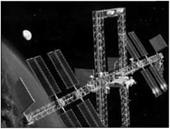 |
To achieve the objectives set out in President Bush’s announcement speech, the TSG adopted an evolutionary 30-year plan for SEI implementation. As the AHWG had done before it, the group put forth a strategic approach that depended on Space Station Freedom and followed initial human missions to the Moon and Mars with phased development of permanent human outposts on these celestial bodies—starting with emplacement, continuing with consolidation, and finishing with operations. Unlike the briefing that had been prepared during the agenda setting process, the 90-Day Study included a highly detailed description of NASA’s vision for the robotic, lunar, and Martian phases of exploration beyond Earth orbit.[210]
The initiative would begin with precursor robotic missions intended to “obtain data to assist in the design and development of subsequent human exploration missions and systems, demonstrate technology and long communication time operation concepts, and dramatically advance scientific knowledge of the Moon and Mars.” The TSG developed a logical progression of robotic explorers to address specific operational and scientific priorities. First, a Lunar Observer program would launch two identical flight systems on one-year polar mapping missions. Second, a Mars Global Network program would launch two identical flight systems carrying orbit – ers and multiple landers to provide high-resolution surface data at several locations. Third, a Mars Sample Return program would launch two identical flight systems to return five kilograms each of Martian rocks, soil, and atmosphere to Earth—this was the centerpiece of the robotic sequence. Fourth, a Mars Site Reconnaissance Orbiter program would launch two orbiters and two communications satellites to characterize landing sites, assess landing hazards, and provide data for subsequent rover navigation. Finally, up to five Mars Rover missions would certify three sites to determine the greatest potential for piloted vehicle landing and outpost establishment.[211]
Lunar Transfer Vehicle would have provided transportation between Space Station Freedom and lunar orbit (Source: 90-Day Study)
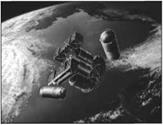 As robotic exploration of the red planet was ongoing, the TSG strategy called for the development of a permanent lunar outpost. The mission concept for achieving this goal was highly complicated, relying on a vast in-orbit infrastructure, numerous spacecraft, and multiple resource transfers. The plan called for “two to three launches of the lunar payload, crew, transportation vehicles, and propellants from Earth to Space Station Freedom. At Freedom, the crew, payloads, and propellants are loaded onto the lunar transfer vehicle that will take them to low lunar orbit. The lunar transfer vehicle meets in lunar orbit with an excursion vehicle, which will either be parked in lunar orbit or will ascend from the lunar surface, and payload, crew, and propellants are transferred. [Then] the excursion vehicle descends to the lunar surface.” A combination of cargo and piloted flights (with four crew members) would be utilized to construct the lunar outpost. The emplacement phase would begin with two cargo flights to deliver the initial habitation facilities, which included a habitation module (to be covered with lunar regolith to provide radiation shielding), airlock, power system, unpressurized manned/robotic rover, and associated support equipment. Emplacement would prepare the way for extended human missions during the consolidation phase, which would include erection of a constructible habitat to provide additional living space and experimentation with in situ resource utilization.[212]
As robotic exploration of the red planet was ongoing, the TSG strategy called for the development of a permanent lunar outpost. The mission concept for achieving this goal was highly complicated, relying on a vast in-orbit infrastructure, numerous spacecraft, and multiple resource transfers. The plan called for “two to three launches of the lunar payload, crew, transportation vehicles, and propellants from Earth to Space Station Freedom. At Freedom, the crew, payloads, and propellants are loaded onto the lunar transfer vehicle that will take them to low lunar orbit. The lunar transfer vehicle meets in lunar orbit with an excursion vehicle, which will either be parked in lunar orbit or will ascend from the lunar surface, and payload, crew, and propellants are transferred. [Then] the excursion vehicle descends to the lunar surface.” A combination of cargo and piloted flights (with four crew members) would be utilized to construct the lunar outpost. The emplacement phase would begin with two cargo flights to deliver the initial habitation facilities, which included a habitation module (to be covered with lunar regolith to provide radiation shielding), airlock, power system, unpressurized manned/robotic rover, and associated support equipment. Emplacement would prepare the way for extended human missions during the consolidation phase, which would include erection of a constructible habitat to provide additional living space and experimentation with in situ resource utilization.[212]
The final step in the TSG strategy was the establishment of a human outpost on Mars. Similar to the lunar program, the Martian sequence would begin with the launch of the crew, surface payload, transportation vehicles, and propellant from Earth to Space Station Freedom. In LEO, the transfer and excursion vehicles would be inspected before setting out on the long journey toward the red planet. “Upon approach to Mars, the transfer and excursion vehicles separate and perform aero – braking maneuvers to enter the Martian atmosphere separately. The vehicles rendez-
Inflatable lunar habitat would have been outpost for up to 12 astronauts (Source: 90-Day Study)
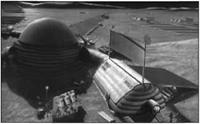 vous in Mars orbit, and the crew of four transfers to the excursion vehicle, which descends to the surface using the same aero-brake. When their tour of duty is complete, the crew leaves the surface in the ascent module of the Mars excursion vehicle to rendezvous with the transfer vehicle in Mars orbit. The transfer vehicle leaves Mars orbit and returns the crew to Space Station Freedom.”[213] Standard mission profiles for crewed flights to Mars would follow two different trajectory classes: one for a 500-day roundtrip with surface stays up to 100 days and one for a 1,000-day roundtrip with surface stays of approximately 600 days. After initial emplacement, the consolidation phase would entail assembly of a constructible habitat and utilization of a pressurized rover for long-range surface exploration.[214]
vous in Mars orbit, and the crew of four transfers to the excursion vehicle, which descends to the surface using the same aero-brake. When their tour of duty is complete, the crew leaves the surface in the ascent module of the Mars excursion vehicle to rendezvous with the transfer vehicle in Mars orbit. The transfer vehicle leaves Mars orbit and returns the crew to Space Station Freedom.”[213] Standard mission profiles for crewed flights to Mars would follow two different trajectory classes: one for a 500-day roundtrip with surface stays up to 100 days and one for a 1,000-day roundtrip with surface stays of approximately 600 days. After initial emplacement, the consolidation phase would entail assembly of a constructible habitat and utilization of a pressurized rover for long-range surface exploration.[214]
As envisioned by theTSG, implementation of SEI would require the construction of a new launch vehicle and multiple spacecraft to travel beyond Earth orbit. The study introduced two primary concepts for a heavy launcher, one a Shuttle – derived alternative and the other based on the proposed Advanced Launch System.[215] [216] As indicated above, the in-space transportation system consisted of transfer and excursion vehicles—these systems would utilize chemical propulsion, although the report called for research funding to investigate nuclear propulsion. For Mars exploration, the transfer vehicle would actually carry the excursion vehicle to the red planet utilizing a large trans-Mars injection stage. The transfer vehicle would
Mars Transfer Vehicle would have propelled crew and mars excursion vehicle to Mars orbit (Source: 90-Day Study)
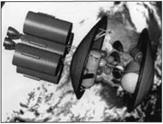
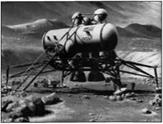 Mars Excursion Vehicle would have transported four astronauts and 25-tons of cargo to Martian surface (Source: 90 Day Study)
Mars Excursion Vehicle would have transported four astronauts and 25-tons of cargo to Martian surface (Source: 90 Day Study)
include a crew module that would be a “single, pressurized structure 7.6 meters in diameter and 9 meters in length with…a life support system that recycles water and oxygen. The crew is provided private quarters, exercise equipment, and space suits that are appropriate for the long mission duration.” The excursion vehicle crew module would provide living space during descent, ascent, and for up to 30 days in case of problems with the surface habitat.44
The TSG developed similar planetary surface systems for both Moon and Martian missions. In fact, the main rationale for development of a lunar outpost was as a testing ground for subsystem technologies for later missions to the red planet. The initial habitats for both outposts would be horizontal Space Station Freedom- derived cylinders 4.45 meters in diameter and 8.2 meters long. Laboratory modules would be attached to add expanded living volume. Each of these habitats would have regenerative life support systems capable of recovering 90% of the oxygen from carbon dioxide and potable water from hygiene and waste water. During the consolidation phase, an expanded habitat would be required to accommodate large crews and longer stays by providing more space. This would be a “constructible [11 meter] diameter inflatable structure partially buried in a crater or a prepared hole. This structure is an order of magnitude lighter than multi-module configurations of equivalent volume. Its internal structure includes self-deploying columns that [217]
telescope upward and lock into place when the structure is inflated. When fully assembled and outfitted, the constructible habitat provides three levels, and has the volume required for expansion of habitat and science facilities. Major subsystems of the constructible habitat include the life support and thermal control systems, pressure vessels and internal structure, communications and information management systems, and interior outfitting.” During this stage, a 100- kilowatt nuclear dynamic power system would begin providing the growing outpost much needed electric power (the plan called for ongoing progression of this capability, leading to a 550-kilowatt system). Initial surface exploration would be conducted using electric powered, unpressurized rovers. These vehicles would only have a range of 50 kilometers with human occupants, although they could be telerobotically operated for missions up to 1,000 kilometers from the outpost. This provided very limited capacity for long-range human exploration, which was nominally the primary reason for making the journey.[218]
The TSG mission plan was designed as the framework for selection of an overall “reference approach.” The 90-Day Study included five different reference approaches, which were intended to provide different options (using only one mission strategy) for achieving President Bush’s goals. The report introduced a set of metrics (cost, schedule, complexity, and program risk) that could be used by policy makers to decide the appropriate timeframe for SEI implementation. The reference approaches simply altered these metrics to provide different milestones for a single strategic plan. Thus, instead of examining numerous technical, operational, or strategic alternatives, the TSG chose to put forward one basic system architecture with slight timeline modifications. The different reference approaches included:
• Reference Approach A: Formulated to establish human presence on the Moon in 2001, using the lunar outpost as a learning center to develop the capabilities to move on to Mars. An initial expedition to Mars would allow a 30-day stay on the surface, with the first 600-day visit in 2018.
• Reference Approach B: A variation of Reference Approach A, which advanced the date of the first human Mars landing to 2011. This would reduce the ability to use the lunar outpost as a learning center for the Mars outpost.
• Reference Approach C: A variation of Reference Approach A, which advanced even further the date of the first Mars mission, but maintained the same expansion schedule for Mars outpost development.
• Reference Approach D: A variation of Reference Approach A, which
slipped all major milestones two to three years.
• Reference Approach E: Formulated to reduce the scale of lunar outpost activity by using only a human-tended mode of operation and limiting the flight rate to the Moon to one mission per year. Three expeditionary missions to Mars (with 90-day surface stays) would precede the 2027 establishment of a permanent outpost with 600-day occupancy.
In essence, this set of reference approaches provided two limited alternatives (Reference Approaches A and E). The only difference between the two was the magnitude of lunar development and the timing of different milestones. There were no alternatives provided that suggested that it was not feasible from a budgetary perspective to attempt both a permanent return to the Moon and human exploration of Mars. In addition, as pointed out above, there were no alternatives that were based on significantly different mission profiles or technical systems. This represented a major shortcoming of the report, which would come back to haunt the space agency in subsequent months and years.[219]
The 90-Day Study included a cost estimate for the TSG’s vision of SEI. It was based on a 30-year planning horizon and employed historical experience to “derive the approximate values for supporting development, systems engineering and integration, program management, recurring operations, new facilities, and civil service staffing levels.” The TSG performed a parametric cost analysis using three regression models developed at different NASA field centers. The Marshall Space Flight Center Cost Model consisted of subsystem level data gathered from past human spaceflight programs, which was employed to estimate space transportation vehicle costs as a function of mass (assigning each reference approach a subjective complexity factor). The Johnson Space Center Advanced Mission Cost Model used a broader dataset drawing on developmental program statistics from NASA and other technology organizations to calculate expected surface system costs. Finally, the Jet Propulsion Laboratory Project Cost Model estimated program costs for robotic missions drawing on past analogous mission figures.[220]
The study provided funding estimates for reference approaches A and E, appraising expected costs from 1991 to 2025 (in constant fiscal year 1991 dollars). The estimates included reserves that accounted for nearly 55% of predicted expenditures, which was intended to allow for programmatic uncertainties. The report included tables that detailed the cost estimates for both reference approaches, separated into key phases:
• Reference Approach A
— Lunar Outpost: $100 billion (FY 1991-2001)
— Lunar Outpost Emplacement &: Operations: $208 billion (FY 2002-2025)
— Mars Outpost: $158 billion (FY 1991-2016)
— Mars Outpost Emplacement & Operations: $75 billion (FY2017-2025)
— Total: $541 billion
• Reference Approach E
— Lunar Outpost: $98 billion (FY 1991-2004)
— Lunar Outpost Emplacement & Operations: $137 billion (FY 2005-2025)
— Mars Outpost: $160 billion (FY 1991-2016)
— Mars Outpost Emplacement & Operations: $76 billion (FY2017-2025)
— Total: $471 billion
The report also included two startling charts, which illustrated the impact of the reference approaches on the overall NASA budget. Starting with a base budget of approximately $ 15 billion, the implementation of both reference approaches would require increasing the annual agency appropriation to $30 billion by FY 2000, where it would stay for another 25 years.[221] In the coming weeks and months, it would become increasingly clear that these budgetary requirements were simply staggering to all outside observers. Admiral Truly and the TSG clearly believed that President Bush was prepared to support a major escalation in annual spending for the space program. This judgment was reached despite the fact that the nation was facing large budget deficits and almost every other sector of the government was expecting significant funding cuts. It proved to be a tremendous miscalculation.











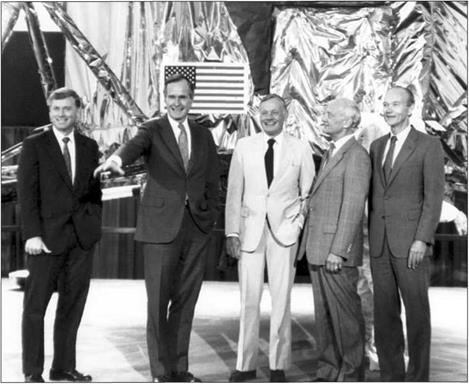
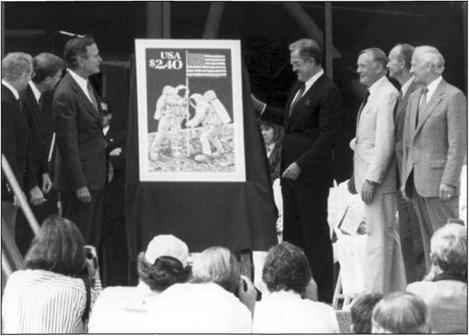
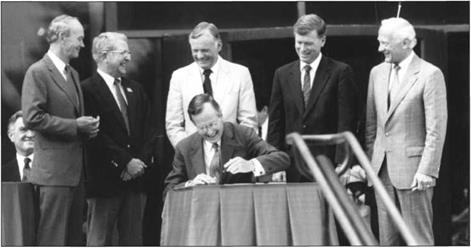
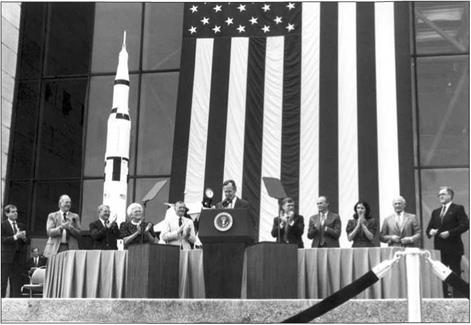
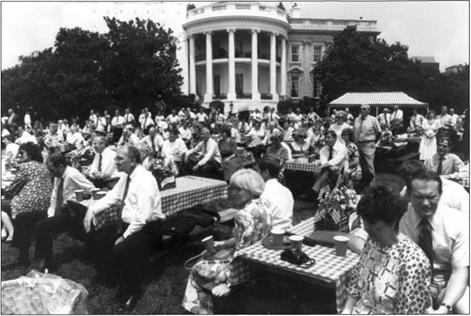


 As robotic exploration of the red planet was ongoing, the TSG strategy called for the development of a permanent lunar outpost. The mission concept for achieving this goal was highly complicated, relying on a vast in-orbit infrastructure, numerous spacecraft, and multiple resource transfers. The plan called for “two to three launches of the lunar payload, crew, transportation vehicles, and propellants from Earth to Space Station Freedom. At Freedom, the crew, payloads, and propellants are loaded onto the lunar transfer vehicle that will take them to low lunar orbit. The lunar transfer vehicle meets in lunar orbit with an excursion vehicle, which will either be parked in lunar orbit or will ascend from the lunar surface, and payload, crew, and propellants are transferred. [Then] the excursion vehicle descends to the lunar surface.” A combination of cargo and piloted flights (with four crew members) would be utilized to construct the lunar outpost. The emplacement phase would begin with two cargo flights to deliver the initial habitation facilities, which included a habitation module (to be covered with lunar regolith to provide radiation shielding), airlock, power system, unpressurized manned/robotic rover, and associated support equipment. Emplacement would prepare the way for extended human missions during the consolidation phase, which would include erection of a constructible habitat to provide additional living space and experimentation with in situ resource utilization.[212]
As robotic exploration of the red planet was ongoing, the TSG strategy called for the development of a permanent lunar outpost. The mission concept for achieving this goal was highly complicated, relying on a vast in-orbit infrastructure, numerous spacecraft, and multiple resource transfers. The plan called for “two to three launches of the lunar payload, crew, transportation vehicles, and propellants from Earth to Space Station Freedom. At Freedom, the crew, payloads, and propellants are loaded onto the lunar transfer vehicle that will take them to low lunar orbit. The lunar transfer vehicle meets in lunar orbit with an excursion vehicle, which will either be parked in lunar orbit or will ascend from the lunar surface, and payload, crew, and propellants are transferred. [Then] the excursion vehicle descends to the lunar surface.” A combination of cargo and piloted flights (with four crew members) would be utilized to construct the lunar outpost. The emplacement phase would begin with two cargo flights to deliver the initial habitation facilities, which included a habitation module (to be covered with lunar regolith to provide radiation shielding), airlock, power system, unpressurized manned/robotic rover, and associated support equipment. Emplacement would prepare the way for extended human missions during the consolidation phase, which would include erection of a constructible habitat to provide additional living space and experimentation with in situ resource utilization.[212] vous in Mars orbit, and the crew of four transfers to the excursion vehicle, which descends to the surface using the same aero-brake. When their tour of duty is complete, the crew leaves the surface in the ascent module of the Mars excursion vehicle to rendezvous with the transfer vehicle in Mars orbit. The transfer vehicle leaves Mars orbit and returns the crew to Space Station Freedom.”[213] Standard mission profiles for crewed flights to Mars would follow two different trajectory classes: one for a 500-day roundtrip with surface stays up to 100 days and one for a 1,000-day roundtrip with surface stays of approximately 600 days. After initial emplacement, the consolidation phase would entail assembly of a constructible habitat and utilization of a pressurized rover for long-range surface exploration.[214]
vous in Mars orbit, and the crew of four transfers to the excursion vehicle, which descends to the surface using the same aero-brake. When their tour of duty is complete, the crew leaves the surface in the ascent module of the Mars excursion vehicle to rendezvous with the transfer vehicle in Mars orbit. The transfer vehicle leaves Mars orbit and returns the crew to Space Station Freedom.”[213] Standard mission profiles for crewed flights to Mars would follow two different trajectory classes: one for a 500-day roundtrip with surface stays up to 100 days and one for a 1,000-day roundtrip with surface stays of approximately 600 days. After initial emplacement, the consolidation phase would entail assembly of a constructible habitat and utilization of a pressurized rover for long-range surface exploration.[214]
 Mars Excursion Vehicle would have transported four astronauts and 25-tons of cargo to Martian surface (Source: 90 Day Study)
Mars Excursion Vehicle would have transported four astronauts and 25-tons of cargo to Martian surface (Source: 90 Day Study)